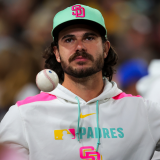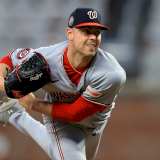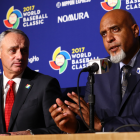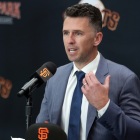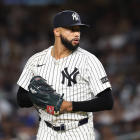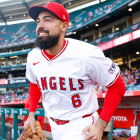Arizona Diamondbacks 2019 season preview: Key departures have Arizona lacking venom
The Diamondbacks are in a state of transition
The Arizona Diamondbacks led the National League West entering September in 2018, then collapsed and missed the playoffs entirely. Now sans Paul Goldschmidt, Patrick Corbin, and A.J. Pollock, is there enough left in desert to compete in the crowded NL?
- 2018 record: 82-80 (49 run differential)
- 2019 depth chart: Click here
- 2019 schedule: Click here
Probable lineup
- Ketel Marte, CF
- Eduardo Escobar, 3B
- David Peralta, LF
- Steven Souza Jr., RF
- Jake Lamb, 1B
- Wilmer Flores, 2B
- Nick Ahmed, SS
- Carson Kelly, C
Bench: Adam Jones, OF; Alex Avila, C; John Ryan Murphy, C; Christian Walker, 1B; Socrates Brito, OF
Last year's Diamondbacks team ranked near the bottom of the majors in park-adjusted offense, per FanGraphs. It's probably not a good sign, then, that three of their four most productive hitters -- Paul Goldschmidt, Daniel Descalso (really), and A.J. Pollock -- are now playing with different NL teams. Nor that the Diamondbacks' offseason additions to their lineup were Flores (who was non-tendered), Kelly (a glove-first catcher), and Jones (a league-averageish hitter). If Arizona is to have a decent offense, it'll be because of internal improvement. Marte, for instance, took a step forward last season after signing a long-term extension. He's a switch-hitting speedster who could see action on both the dirt and in the outfield. Peralta is an underrated platoon bat, and Lamb has the chance to be one if he can find more consistency. Beyond those three, the D-Backs need Souza to regain his 2017 stroke. Escobar has been an average or better hitter in four of the past five seasons and there's no reason to lower the rim just yet. Ahmed is one of the best shortstop defenders in baseball, yet the real intrigue is in his increased offensive output over his last 800 or so plate appearances. He's not going to be confused for Francisco Lindor, but getting closer to, say, Jordy Mercer levels would make him a heck of an asset. Kelly came over in the Goldschmidt trade and should finally get his chance to be a starting backstop. Jones deserved a gig, and Souza's proneness to slump and injury means he could get a legitimate crack at playing time. Former top prospect Socartes Brito is without options and could be expelled from the roster once Jarrod Dyson gets healthy -- presuming, anyway, the D-Backs remain committed to a three-catcher setup.
Probable rotation
- Zack Greinke, RHP
- Robbie Ray, LHP
- Zack Godley, RHP
- Luke Weaver, RHP
- Merrill Kelly, RHP
The other big loss the Diamondbacks suffered was Corbin. Greinke continues to earn the Greg Maddux comparisons by easily adjusting to life with upper-80s velocity. Ray wasn't quite as good last season as the year before. That's to be expected: His wavering command makes him a hit-or-miss mid-rotation starter. Godley also took a step back. His game hinges on coercing batters to swing at pitches outside the zone. They were a little less likely to last season, resulting in a bloated walk rate and harder contact. He'll need to bait his hook better this year. Weaver came over from the Cardinals and Kelly from Korea. Both need their breaking balls to improve to stick in the rotation for the long haul. Taijuan Walker probably won't be a factor until the second half after undergoing Tommy John surgery last July. Arizona does have a few younger arms worth watching: Taylor Clarke, Taylor Widener, and Jon Duplantier could all reach the majors before the season ends.
Probable bullpen
Closer: Archie Bradley, RHP
Setup: Greg Holland, RHP; Yoshihisa Hirano, RHP
Middle: Yoan Lopez, RHP
LOOGY: Andrew Chafin
Long: T.J. McFarland, LHP
Depending on which version of Holland shows up, the D-Backs could have a formidable back-end of the bullpen. Bradley and Hirano are high-quality arms, with the latter atoning for his low-90s heat behind a high-quality splitter -- batters hit .177 against it and whiffed on nearly 40 percent of their swings. Chafin has averaged fewer than three batters faced per appearance over the last three seasons, telling you all you need to know about his role. He's been more effective against righties than you'd think, however. Regardless, his slider missed bats on more than half the swings on it last season. That'll work. Keep an eye on Lopez, whose big-time arm strength and slider could pave a way for him to pitch high-leverage innings. McFarland isn't going to post a 2.00 ERA again, but we respect his ability to endure by throwing his slow sinker over and over again. His groundball rates have threatened 70 percent in each of the past two years, per Statcast. The D-Backs will be without Silvino Bracho for the season. Expect to see some combination of Matt Andriese, Robby Scott, Jimmie Sherfy, and Joey Krehbiel in the bullpen between now and season's end.
Even flow
The truth about the Diamondbacks is they aren't a bad team -- even after suffering the big losses they did over the course of the winter.
Baseball Prospectus pegs Arizona to win 81 games; FanGraphs says 78. If the D-Backs were in the American League, that would put them close enough to the playoff race to label them a fringe contender. In the NL, it's harder to see a clear path. The Dodgers and Rockies appear better, and the Padres are a sexier dark horse pick.
The main issue here is it feels like the D-Backs lack genuine upside. You can foresee a scenario where most everything clicks … and they win 88 games. That isn't meant as an insult so much as an explanation for why we don't regard them as a legitimate contender. Obviously things can change. Maybe they find themselves in contention come July and make a season-altering trade, much the way they did two summers ago with J.D. Martinez.
But yes, the D-Backs are an all right team. They'll probably win 80-something games and finish third without exciting or inciting much in the way of playoff hopes.
Worse, but not much cheaper
One interesting wrinkle about the Diamondbacks is that their payroll hasn't dropped much despite the exodus of talent. Usually, stars leave and the team saves a lot of money in the process. Not here. Cot's Contracts projects them to enter the campaign with a payroll around $121 million -- only about $10 million less than where they were last season.
The catch is that a lot of the D-Backs' payroll is devoted to two players: Greinke and forgotten outfielder Yasmany Tomas. Collectively, those two are responsible for nearly $50 million. They're the only two players on the roster making more than $8 million, too. This is the definition of a top-heavy club.
Barring a payroll spike or a surprising trade, Greinke and Tomas are going to remain the top earners on the club for at least one additional season -- next year they'll combine to make more than $52 million. (Tomas will go away after that, with 2021 serving as the final season on Greinke's contract.)
It just goes to show, sometimes total payroll doesn't tell the whole story.
If they sell ...
Of course, you combine those two subheads and you get to thinking maybe Arizona will decide this summer to continue its retooling by trading off more pieces.
If that happens, the Diamondbacks should have suitors lining up for a chance at landing Peralta, Marte (who would probably be deemed off limits), Escobar, Ray, Bradley, and Hirano. Lamb and Ahmed could also draw looks, depending on how their seasons are going.
None of those are likely to return a big-time prospect package, but it's something the Diamondbacks will have to consider if they're unwilling to spend the money required to get back on the competitive track.


